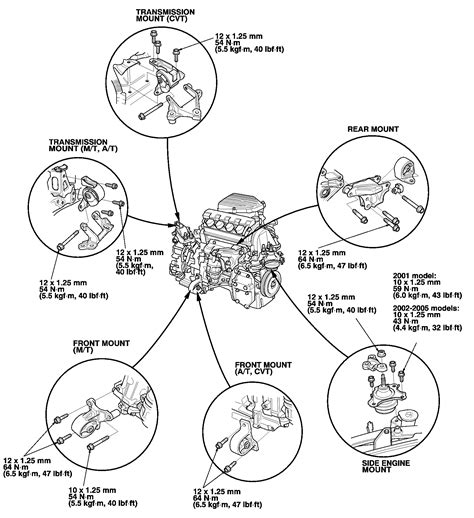Explore the significance, functions, and types of engine mounts for optimal vehicle performance, complete with detailed diagrams for better understanding.Engine mounting is a crucial aspect of vehicle design that often goes unnoticed by everyday drivers. However, it plays a vital role in ensuring the performance and reliability of your vehicle. In this blog post, we’ll dive into the specifics of engine mounting, exploring its various functions and the different types of engine mounts used in modern automobiles. We’ll also provide a detailed engine mount diagram to help visualize how these components work together to support the engine and enhance overall performance. By understanding the importance of engine mounting, you’ll appreciate how this seemingly simple system contributes significantly to the overall driving experience, from reducing vibration to improving stability. Join us as we break down the essentials of engine mounts and their impact on vehicle dynamics.
Understanding Engine Mounting
Engine mounting is a crucial aspect of automotive design that refers to the methods and materials used to secure an engine within a vehicle’s chassis, ensuring not only stability but also reducing vibrations and noise that can adversely affect driving comfort and operational efficiency. While the primary function of engine mounts is to provide support to the engine, they also play a significant role in the vehicle’s overall performance and longevity by dampening vibrations generated by the engine during operation, thereby preventing excessive wear on other components.
There are several types of engine mounts, each designed with specific characteristics to accommodate different engine configurations and vehicle designs, making it essential for manufacturers to consider factors such as weight, size, and the engine’s orientation when selecting the appropriate mounting system. In addition to traditional rubber mounts, advancements in technology have led to the development of hydraulic and electromagnetic mounts that offer improved vibration isolation and adaptability to changing driving conditions. These innovations are particularly important for modern vehicles, where performance expectations are higher, and driving experiences are increasingly demanding.
The following table provides an overview of the various types of engine mounts, outlining their characteristics and advantages:
| Type of Engine Mount | Description | Advantages |
|---|---|---|
| Rubber Mounts | Traditional mounts made from rubber that absorb vibrations. | Cost-effective and durable. |
| Hydraulic Mounts | Use fluid to dampen vibrations and adjust to engine movements. | Offer improved isolation and response. |
| Electromagnetic Mounts | Utilize magnetic forces to adapt isolation levels dynamically. | Provide superior vibration control and enhanced comfort. |
Understanding how engine mounting operates and its function in a vehicle is not only important for those engaged in automotive engineering and design but also for vehicle owners who will benefit from enhanced performance and durability through well-maintained mounts. Ultimately, recognizing the impact of engine mounts on the overall vehicle system can lead to more informed choices regarding maintenance and upgrades, ensuring
Functions of Engine Mounts
The functions of engine mounts are crucial to the overall performance and safety of a vehicle, as they serve multiple purposes that contribute significantly to the stability and efficiency of the engine while simultaneously dampening vibrations and noise produced by the engine in operation.
One of the primary functions of engine mounts is to secure the engine to the vehicle’s frame, which not only prevents excessive movement during acceleration and deceleration but also ensures that critical engine components align properly with other systems such as the transmission and drive shaft, thereby enhancing the overall functionality of the vehicle.
Additionally, engine mounts act as vibration dampeners, absorbing shocks and vibrations that could otherwise affect the vehicle’s chassis, passengers, and overall ride quality; this is particularly important in modern vehicles where comfort and smoothness are paramount, and the absence of effective mounts could result in increased wear and potential damage to various engine components.
Lastly, it’s worth noting that the different types of engine mounts, such as rubber, hydraulic, or solid mounts, each play a role in achieving these functions, emphasizing the importance of selecting the right type for specific vehicle applications to maintain performance and safety standards.
| Type of Engine Mount | Function |
|---|---|
| Rubber Mounts | Absorb vibrations and accommodate engine movement. |
| Hydraulic Mounts | Provide enhanced dampening and noise reduction. |
| Solid Mounts | Offer maximum stability and are often u
Types of Engine MountsWhen it comes to understanding engine mounts, one must dive into the distinct categories that serve as the backbone of automotive stability, which include rubber engine mounts, hydraulic engine mounts, solid engine mounts, and pneumatic engine mounts. Each type of engine mount is engineered to fulfill specific operational requirements, ensuring that the engine remains securely fixed while accommodating the vibrations and movements produced during engine operation. Rubber engine mounts are one of the most commonly used types in vehicles due to their excellent vibration-damping characteristics; these mounts are typically composed of a mixture of rubber and metal that help isolate engine noise and vibration, offering a smoother driving experience. In contrast, hydraulic engine mounts utilize a liquid-filled chamber designed to further minimize vibration and increase comfort, making them particularly popular in luxury vehicles where noise reduction is prioritized. Another variation, solid engine mounts, provide a more rigid support system, often utilized in performance cars where enhanced responsiveness and direct feedback are necessary, albeit at the cost of increased noise and vibration. Lastly, pneumatic engine mounts use air pressure to absorb shock and reduce vibrations, functioning efficiently under various load conditions, making them a preferred choice in high-perform Engine Mount Diagram ExplainedIn the world of automotive engineering, the engine mount serves as a critical component that securely holds the engine in place, absorbing vibrations while ensuring that the engine functions smoothly, and thus, understanding the intricate details presented in an engine mount diagram is essential for both technicians and enthusiasts alike. The engine mount diagram provides a visual representation of how these mounts are positioned in relation to the engine and the vehicle’s chassis, typically depicting various components such as the mounting brackets, insulation pads, and the bolting system, all of which work synergistically to maintain the stability of the engine during operation while minimizing unwanted noise and vibrations that could compromise the driving experience. Moreover, an engine mount diagram often illustrates not only the physical configuration but also technical specifications, allowing individuals to grasp the mechanics of the engine’s placement; for instance, comparing solid mounts to hydraulic mounts highlights the key differences in performance and response, which can significantly affect vehicle dynamics, driving comfort, and overall longevity of the engine and vehicle system. Importance of Engine Mounting in Vehicle PerformanceThe significance of engine mounting cannot be overstated, as it plays a critical role in ensuring the smooth operation and overall performance of a vehicle’s engine, fundamentally impacting not just the vehicle’s aesthetics, but more importantly, its safety, comfort, and durability. Acting as a resilient link between the engine and the vehicle’s chassis, the engine mounts effectively absorb vibrations and isolate noise, thereby enhancing the driving experience while safeguarding the integrity of surrounding components; furthermore, they are meticulously designed to accommodate the dynamic loads experienced during acceleration, braking, and cornering, which allows for optimal performance under a variety of conditions. Moreover, the importance of proper engine mounting also extends to fuel efficiency and emissions, as the alignment of the engine due to well-maintained mounts can significantly reduce unnecessary vibrations and misalignments that typically lead to increased fuel consumption and higher pollutant emissions; thus, investing in engine mount maintenance can yield long-term benefits, making it a crucial factor in any comprehensive vehicle performance strategy. Frequently Asked QuestionsWhat is the purpose of an engine mount? The primary purpose of an engine mount is to secure the engine to the vehicle’s frame while isolating vibrations and noise from the engine to provide a smoother driving experience. What materials are commonly used for engine mounts? Engine mounts are typically made from rubber, metal, and sometimes polyurethane, providing a balance of strength and vibration absorption. How can I tell if my engine mount is damaged? Signs of a damaged engine mount include excessive engine vibrations, slouching or misalignment of the engine, and unusual noise from the engine bay during acceleration or deceleration. What are the different types of engine mounts? There are several types of engine mounts, including hydraulic mounts, solid mounts, and torque mounts, each designed for specific applications and performance needs. Is it difficult to replace an engine mount? Replacing an engine mount can vary in difficulty depending on the vehicle make and model, but it typically requires mechanical knowledge and tools. It is advisable to consult a professional if unsure. What should I look for in an engine mount diagram? An engine mount diagram should clearly display the positioning of the mounts, any associated brackets, and the specific bolts and hardware required for installation or replacement. How often should engine mounts be inspected? Engine mounts should be inspected during regular maintenance intervals, especially if the vehicle shows signs of excessive vibrations or noise, to ensure they are functioning properly. İlgili Yazılar |





